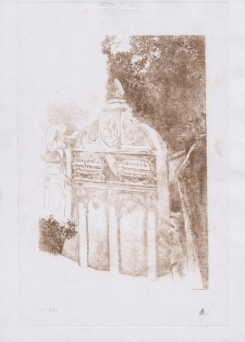Jiří Běhounek (1929–2005), Tombstone of Rabbi Judah Loew ben Bezalel, known as the Maharal (ca. 1525–1609), and his wife Perl bat Shmuel at the Old Jewish Cemetery in Prague, 1996
července 2009
The 7th of September 2009 will be the 400th anniversary of the death of an important figure in Jewish history – Rabbi Judah Loew ben Bezalel, also known as Rabbi Loew or the Maharal (the Hebrew acronym of morenu ha-rav leva – Our Teacher the Rabbi Loew). To commemorate this anniversary (yahrzeit), the Jewish Museum in Prague is preparing a unique exhibition that will be on display at the Imperial Stables of Prague Castle between the 5th of August and the 8th of November 2009. This exhibition will focus not only on the Maharal’s work and legacy, but also on the places in Prague’s former Jewish Town (in 1850 renamed Josefov in honour of the enlightened Emperor Josef II) that are associated with his life and work. One such important site is the Maharal’s grave, which is without doubt one of the main attractions of Josefov. An important scholar and spiritual authority of his day, the Maharal gained recognition for developing traditional education and is also credited with various deeds, including the creation of an artificial being – the golem. His last resting place, which he shares with his second wife Perl bat (daughter of) Shmuel, is also shrouded in legends and regarded with special esteem. This is borne out by, among other things, the countless number of kvitlach (prayer notes on small pieces of paper) that people place at his grave in the hope that their wishes will come true with the Maharal’s help. In connection with the publication of many Jewish fantasy stories from Prague at the end of the 1840s and, in particular, with the subsequent development of tourism in the 20th century, the Maharal’s tombstone became a popular motif in genre paintings and illustrations. Among the latter is this print by the prominent Czech illustrator Jiří Běhounek (1929–2005), who devoted a large part of his work to Jewish legends and fairytales (his illustrations appear, for example, in Leo Pavlát’s Osm světel [Eight Lights] and Pomsta čarodějky Simy [The Revenge of the Sorceress Simah] and Isaac Bashevis Singer’s Rabbi and the Sorceress.



![[subpage-banner/6_Media.png]](https://c.jewishmuseum.cz/images/subpage-banner/6_Media.png)

![[homepage-banner/incident.jpeg]](https://c.jewishmuseum.cz/images/homepage-banner/incident.jpeg)